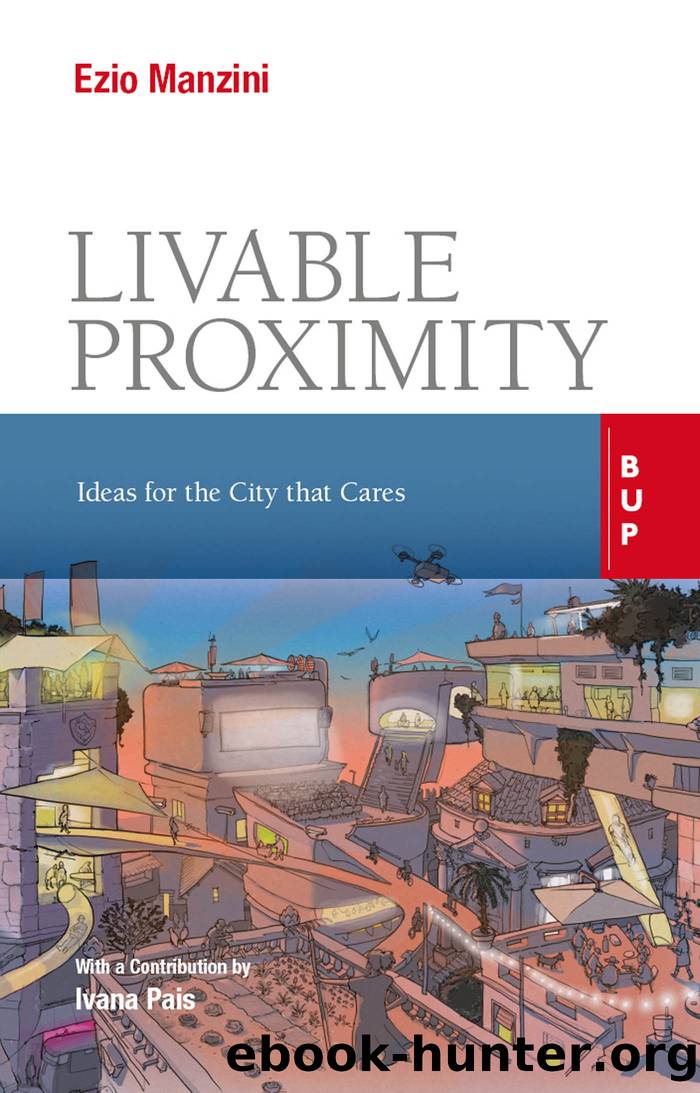Livable Proximity by Ezio Manzini

Author:Ezio Manzini
Language: eng
Format: epub
Publisher: Egea
3.6 Proximity that cares
The Circle model is the expression of a strategy to approach the city that cares. But as mentioned, there can be other paths to this objective. What we will speak of now does not start from the direct construction of communities, but from the action on the system of proximity as a context in which various communities can flourish.
Let us imagine an elderly person who lives alone, or in a couple, in the neighborhood where he has lived for a long time; with the shops and cafés on the corner that he knows (and that know him); with the people he encounters often and greets, and who greet him; with a pharmacy and clinic close to home; with a pleasant community center, a network of professionals who help him in moments of difficulty and who intervene to do what he cannot do by himself, or with his friends and neighbors; and obviously, for possible emergencies. The daily life of this person resembles the way things were in the past (and in part can still be found today in some neighborhoods and villages), but not in the present: today, in general, the situation is very different. Yet, although it is not widespread, this situation is also not an unattainable utopia. It is a project-based vision, something that does not exist but could if the right moves were made, the actions needed to create a new city that cares.
To discuss this, let us again go to Barcelona and take a closer look at the Superilles program we spoke of in Chapter 2. In presenting it and commenting on it we observed that its first phase was the transformation of the use of the streets, going from the monofunction of transport (and parking) to the multifunction of a public space: streets as public spaces open to various possible activities. At the same time, we observed that this initial intervention created the conditions to propose the reorientation on a territorial basis of various public policies: from social services to housing, from taking care of the environment and public green areas, to labor and the regeneration of the democratic life of the city. All of this was observed from the perspective of the evolution of the Superilles program towards a new ecology of the city. Now we can see more closely how things went, and how all of this also leads to the city that cares.
The first phase of the Superilles program, essentially based on the transformation of streets into multifunctional public spaces, was followed by a series of interventions called Superilles socials, and a third step is scheduled, called Superilles integrals.
Download
This site does not store any files on its server. We only index and link to content provided by other sites. Please contact the content providers to delete copyright contents if any and email us, we'll remove relevant links or contents immediately.
Kathy Andrews Collection by Kathy Andrews(11730)
The remains of the day by Kazuo Ishiguro(8821)
Paper Towns by Green John(5089)
Spare by Prince Harry The Duke of Sussex(5072)
Industrial Automation from Scratch: A hands-on guide to using sensors, actuators, PLCs, HMIs, and SCADA to automate industrial processes by Olushola Akande(4979)
The Body: A Guide for Occupants by Bill Bryson(4974)
Machine Learning at Scale with H2O by Gregory Keys | David Whiting(4179)
Be in a Treehouse by Pete Nelson(3947)
Never by Ken Follett(3790)
Harry Potter and the Goblet Of Fire by J.K. Rowling(3774)
Goodbye Paradise(3727)
Into Thin Air by Jon Krakauer(3312)
The Remains of the Day by Kazuo Ishiguro(3293)
The Cellar by Natasha Preston(3261)
The Genius of Japanese Carpentry by Azby Brown(3224)
Fairy Tale by Stephen King(3220)
120 Days of Sodom by Marquis de Sade(3180)
The Man Who Died Twice by Richard Osman(2997)
Drawing Shortcuts: Developing Quick Drawing Skills Using Today's Technology by Leggitt Jim(2996)
